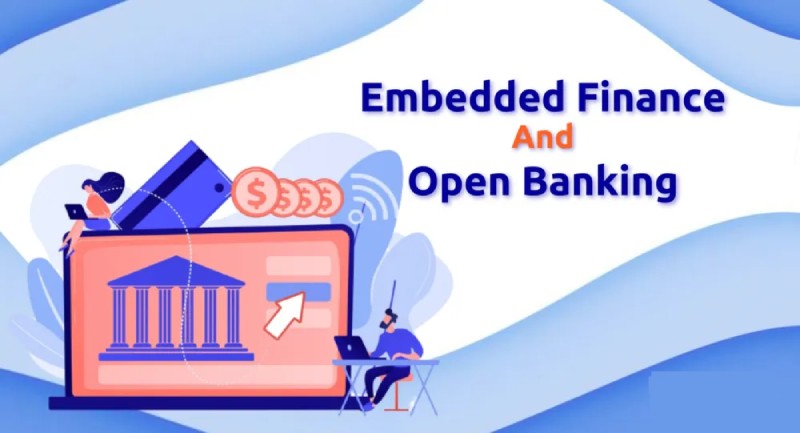Business
Embedded Finance – What is It, How is It Different from Open Banking and Defi, Benefits & Drawbacks, and More

Embedded Finance: What Is It?
The integration of banking and other financial services with non-financial applications and services is known as embedded finance. Businesses are using application programming interfaces (APIs) connected to financial partners to integrate banking, lending, insurance, and investment services with their client offers.
In a way, embedded finance is nothing new: the concept of buy now, pay later (BNPL) is predicated on loans from unseen third parties provided at the point of sale. However, with smartphones and APIs so widely used, customers can access financial services from anywhere, and businesses may increase client loyalty and income streams.
Comprehending Embedded Finance
Embedded finance integrates savings and checking accounts, loans, insurance, debit cards, investing tools, and other financial services into the platforms of businesses that don’t normally deal with finance. This is the outcome of collaborations between traditional financial institutions and technology partners.
It’s not new for financial products or services to be incorporated into nonfinancial business transactions. Direct-to-consumer auto loans and finance, for instance, were first made available by numerous automakers decades ago, while store-branded charge cards for department shops and other merchants predate mass-market credit services. Nonetheless, embedded finance has become more well-known—first as a concept in the mid- to late 2010s, and subsequently as a result of developments in commerce and fintech apps. These include the rivalry from new and creative companies, changing consumer expectations, the fact that many people are decoupling traditional banking operations, the popularity of software as a service (SaaS) models and APIs, and the search for new market opportunities.
Embedded finance proponents claim that this marks a significant shift from both the traditional banking practices and the traditional fintech model, as it allows nonfinancial companies to seamlessly integrate financial services into their platforms and connect with fintech and banks through APIs. If true, it would represent a dramatic change in the way financial services are provided and experienced, with far-reaching effects on the future of banking and the fintech sector. It would have to be distinct from the following in order to do that:
An app-based counterpart to auto dealers who connect clients with independent lenders or provide loans directly to consumers. For a long time, businesses have allowed consumers to use branded credit cards to pay for the purchase of new cars or other goods. These transactions serve to augment the main transactions that take place between a customer and a business, but they may also aid in sales and maintain customer loyalty.
It must also be distinct from how fintech companies use cellphones and APIs to provide faster, more affordable ways for customers to transfer money, apply for credit, and make stock market investments.
The idea that banking and other financial services are better understood as components of a single customer experience rather than as separate businesses with distinct locations and apps helps to illustrate the concept. To demonstrate how embedded finance might represent a new step beyond its predecessors, let’s look at how it functions and a few examples.
The Workings of Embedded Finance
Embedded Finance is Emerging as a Result of Four Major Changes:
1. A shift to e-commerce:
As companies incorporate financial services into their digital platforms as a part of a unified customer experience, embedded finance has become more prevalent as a result of the digitalization of commerce. In order to increase sales, e-commerce businesses integrate rewards programs, branded credit cards, and BNPL financing into their checkout processes. In order to draw in producers and customers, on-demand platforms such as freelance markets and ride-hailing applications now offer digital wallets, payment methods, and money management tools.
2. Technological Integration Advances:
Fintech and APIs are developing quickly, making it easier and more scalable to integrate financial services into nonfinancial platforms. Real-time data connections, electronic Know Your Client, and digital onboarding make verified transactions quicker and much simpler for the customer. SaaS and subscription services might include lines of credit for business customers, in-app invoicing, and flexible payment alternatives thanks to APIs.
3. Shifts in consumer expectations:
Due to a demand for convenience and simplified experiences, consumers are becoming more at ease utilizing atypical suppliers for financial services. The widespread use of digital banking, e-commerce, fintech apps, and smartphones has contributed to these shifts in mindset.
4. Reaching the Underserved:
It has been a challenging issue to assist those who are not taken care of by conventional banks and other financial organizations. Some contend that democratizing finance and increasing access to financial goods could be achieved by further integrating money into routine activities. Others envision behavioral economic strategies that could assist people who would not have the time or knowledge to look for such services separately by directly integrating insurance possibilities into, say, a ride-sharing transaction and simplifying other options.
Advantages of Integrated Finance
The following characteristics of embedded finance, in addition to opening up new income sources and profit opportunities, can help both the supplier and the customer:
Benefits of Behavioral Economics:
Behavioral economists advocate for nudge-like tactics that encourage clients to make better financial decisions. Many people’s ability to make better, more informed, or simpler financial decisions could be enhanced by incorporating options like purchasing auto insurance.
Reaching beyond finance, risk management, bank accounts, and money transfers allows businesses to serve as a one-stop shop for a variety of financial needs tailored to specific services and goods.
Increasing Security:
Strict regulatory security standards are already met by vetted financial technology partners with expertise in asset management, lending, and payments, which lowers the risks associated with handling everything internally.
Enhancing The Experience For Users:
Convenience and time can be increased by letting users stay in one ecosystem, expediting identity checks, speeding up payments, and having the consumer practically out the door before they leave.
Boosting Engagement and Loyalty:
Establishing yourself as the go-to financial services provider for clients outside of business dealings may foster brand affinity and trust while raising engagement. Financial partners can provide businesses discounts on bulk processing, which they can then pass along to their most devoted clientele.
Expanding financial accessibility:
Financial services could be made more accessible and economical while also serving a larger population.
More items to Offer:
Retailers, platforms, SaaS companies, and other companies can increase the range of products they offer to better serve clients in one location by utilizing embedded finance. Beyond one-time deals, providing loans, insurance, and payments creates a “stickier” relationship.
Embedded Finance’s Disadvantages
Risks for companies and customers include overreaching, complicated integrations, modifications to applicable laws and regulations, liability for partner actions, concerns about data privacy, growing security vulnerabilities, and alienating customers by monetizing every interaction and lengthening checkout times with an increasing number of checkboxes and opt-outs if improperly handled. Here are a few more possible disadvantages:
Behavioral Economic Traps:
While there may be a benefit in encouraging customers to make better decisions, such as substituting healthier options for high-calorie foods at the checkout counter, there is also a chance that the opposite may occur. Customers could use this seamless service to make important financial decisions without even recognizing or thinking about the consequences.
Complexity:
Further technological and operational risks arise when integrating with one or more financial services partners through APIs, guaranteeing dependable connections, and exchanging data across several systems. It increases the possibility for cyber breaches, system disruptions, and performance lags. It also increases the attack surface for hackers.
Customer Overload:
Attempting to create an all-inclusive financial experience too quickly across too many domains can overwhelm consumers and damage their trust if seamlessness promises are broken or if it just makes it seem like a trustworthy company is now attempting to obtain your money through additional means—such as opt-outs, checkboxes, and the like—in order to complete a transaction.
Heightened Requirement For Customer Service:
A high degree of customer service is frequently necessary for financial services. New businesses in this field might find it difficult to supply this, which could sour connections with clients.
Loss of Focus:
This is perhaps the largest possible drawback of embedded finance. If a business with embedded financing and ancillary services expands its value proposition, it runs the danger of losing its competitive edge and drawing attention away from the features that first drew customers in and made them want to use their services.
Risks Related To Security and Privacy:
Gathering financial information from users for tailored services might be dangerous if a platform breach exposes private information. Partners must uphold strict security protocols, even while businesses may become the focus of sophisticated cyberattacks. Additionally, new privacy laws are limiting the amount of data that businesses may share with one another.
Regulatory compliance:
As a service distributor, platforms that incorporate regulated financial activities such as lending, payments, and investments also acquire compliance laws pertaining to client identification, data usage, privacy protection, transparency disclosures, equity access, and fair lending.
Dependency on Third Parties:
A business may be entrusting a considerable portion of its customer interactions to other parties. The risk that embedded financial services won’t be delivered satisfactorily arises from depending on banks or other third-party fintechs to provide them.
Reputational Risk:
Even if an embedded financial service is a little portion of a company’s total business, a security breach or failure could harm the company’s brand.
Erosion of Trust:
Businesses may implement these services under the guise of improving financial accessibility or user-friendliness, but in the end, clients may perceive them as more of a bother than a benefit.
What Distinguishes Embedded Finance from Open Banking?
Specifically, open banking refers to banks that grant third-party financial services API access to consumer data and account functions. It makes it possible for outside fintech businesses to develop services and apps based on banking data, giving account users access to more tailored, convenient, and valuable offers. Hence, open banking, often referred to as banking-as-a-service, involves banks opening up data flows and services that comply with regulations.
Using open APIs and infrastructure, embedded finance focuses on nonbanks integrating financial services. Thus, while embedded finance is about extending financial instruments into new distribution channels, open banking lays the groundwork for embedded finance by allowing regulated back-end financial organizations to share capabilities.
What Distinguishes Embedded Finance from DeFi?
The goal of decentralized finance, or DeFi for short, is to automate procedures and leverage blockchains, smart contracts, and cryptocurrency to make financial systems more accessible, global, and open without relying on central authority. Therefore, the goal of DeFi is to create alternative financial railroads through the use of decentralized technologies, which some supporters believe eliminates the need for middlemen between service providers and clients.
By using centralized or proprietary technology like APIs, embedded finance aims to integrate financial services into nonfinancial situations as opposed to eliminating middlemen. In essence, it makes it possible for non-financial businesses to sell financial products under a white label from regulated traditional financial institutions.
The Final Word
With its smooth integration of financial services and products into non-financial contexts, embedded finance has the potential to be a huge development in the financial services industry. Through their platforms, businesses that have hitherto operated outside of the finance industry are now able to provide banking, lending, insurance, and investing services. Embedded finance, made possible by the use of APIs from specialist suppliers, expands product offerings, improves user convenience, and creates new revenue streams for companies. The movement, which integrates financial services into routine consumer and corporate interactions, represents a break from traditional banking and fintech models.
Embedded finance is a contemporary financial phenomenon that is fueled by changes in consumer behavior, technology advancements, and the digitalization of business. Wallet, payment, and wealth management features are becoming ingrained in e-commerce, ride-hailing apps, and freelance marketplaces, among other platforms. These linkages are now possible because to the growth of SaaS models and APIs, which also satisfy customers who feel more at ease with atypical financial service providers. The ramifications for fintech and banking in the future are significant, suggesting that the provision and consumption of financial services may undergo a significant shift.
-

 Business3 weeks ago
Business3 weeks agoPrakash and Kamal Hinduja: Driving Social and Environmental Change
-
Education4 weeks ago
Fred DuVal: University Leadership as a Critical Resource for Climate Change Research and Life-Saving Solutions
-

 Health3 weeks ago
Health3 weeks agoThe Hinduja Brothers Commitment to Global Health: Empowering Communities Across Borders
-

 Cryptocurrency3 weeks ago
Cryptocurrency3 weeks agoDesigned For The Masses: How Akasha (AK1111) Is Unlocking Crypto For The Next Billion Users
-

 Cryptocurrency4 weeks ago
Cryptocurrency4 weeks agoNexaglobal & Future World Token (FWT): Could This Be the Next Big Crypto Investment of 2025?
-

 Sports4 weeks ago
Sports4 weeks agoWomen’s NCAA Tournament 2025 Sweet 16: Full Schedule, Fixtures, Teams, Bracket, and How to Watch March Madness Basketball Match Live
-

 Startup1 week ago
Startup1 week agoCost-Saving Strategies Every Small Business Owner Should Know to Boost Efficiency
-

 Startup3 weeks ago
Startup3 weeks agoMatthew Denegre on the Art of Deal Sourcing: Finding the Right Investment Opportunities



















